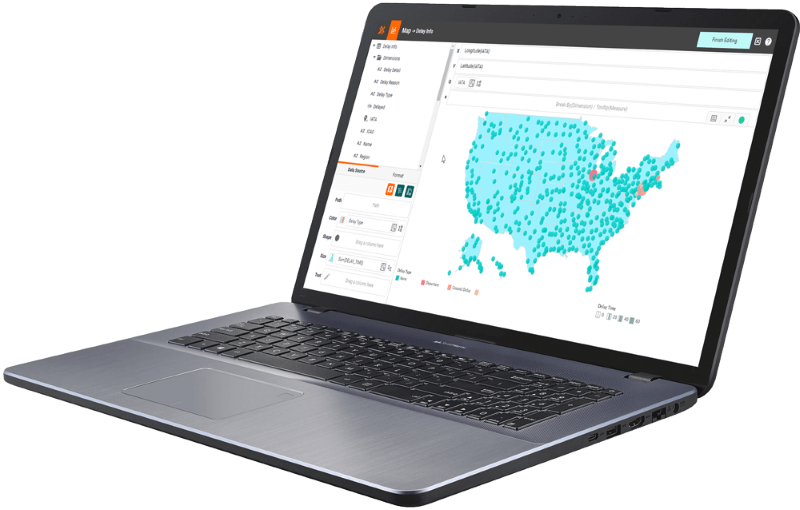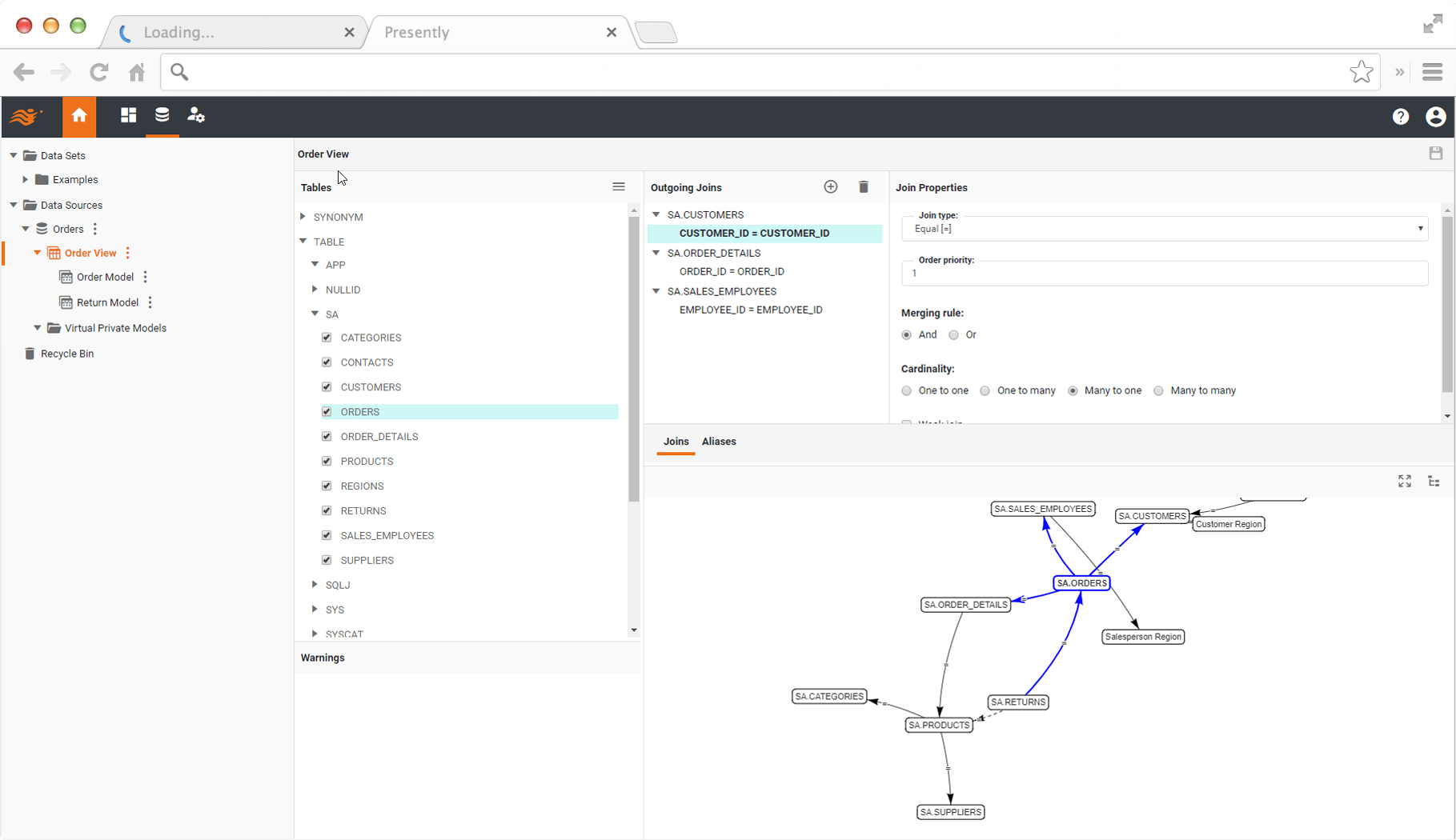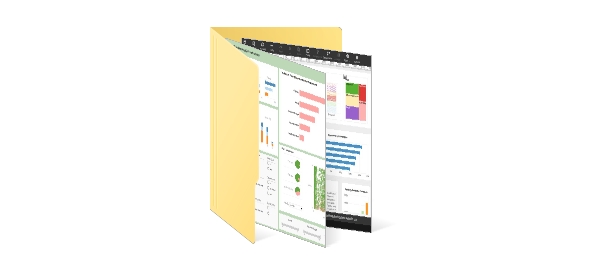SQL Query & Visual Reporting
InetSoft's SQL capabilities are flexible enough to empower skilled designers while self-service users simply point and click. Beyond building queries, InetSoft's data mashup engine seamlessly integrates disparate data sources. And data output can be quickly visualized within the same web app that delivers the dashboards and reports.

Hand Write or Visually Compose SQL Queries
Designers and analysts have the freedom to choose how to write SQL queries in the web app. SQL-fluent users might prefer to hand write SQL aided with meta-data to have maximum flexibility. Other power users would simply compose queries visually. This approach removes the need for exact knowledge of particular database's SQL syntax.
While the default data access mode is live, the resulting data blocks can be set up as automatically updated caches. A cache relieves the load on a source database from visual analyses and interactive reporting.
Data Mashup and Visual Reporting
InetSoft's data mashup engine, which is part of the web query app, allows designers to bring together disparate databases and other data sources. Queries and data mashups with any level of complexity will normally be refined in an iterative fashion.
InetSoft's web app also integrates data visualization so that a designer can flexibly inspect many aspects of the query results. Designers then seamlessly create dashboards and reports in the same environment.

Secured and Governed Self-Service
Designers can empower end users with powerful self-service while maintaining control. InetSoft's data model is built with security control at the data cell level. Many levels of runtime controls allow administrators to prevent run-away queries.
The underlying high performance query cache allows queries to be offloaded and run at designated times. Real time dashboards and reports usage then operates against the cache and generates no load on the database.

From Atlassian to InetSoft: Revolutionizing BI Dashboards at Forensic Palynology Services
In the intricate world of forensic science, where microscopic pollen grains can unravel criminal mysteries or reconstruct environmental histories, data management is paramount. Forensic Palynology Services (FPS), a leading consultancy specializing in pollen-based forensic analysis, has long relied on robust IT infrastructure to handle vast datasets from crime scenes, archaeological digs, and environmental impact assessments. With terabytes of SQL-stored data encompassing sample metadata, analytical results, and case timelines, FPS needed a business intelligence (BI) solution that could transform raw data into actionable insights swiftly and securely.
For years, FPS leaned on Atlassian's suite—primarily Confluence integrated with Jira dashboards and third-party plugins—for their BI needs. While Atlassian excelled in collaborative project management, it fell short in delivering sophisticated, SQL-native dashboarding capabilities tailored for forensic workflows. As the company scaled from 50 to over 150 analysts and support staff, the limitations became evident: cumbersome custom scripting for SQL queries, escalating licensing fees, and mounting administrative overhead. In 2024, FPS embarked on a bold migration to InetSoft's Style Intelligence BI platform, a decision that not only streamlined their operations but also yielded substantial savings across licensing, resources, overhead, and support. This article delves into the journey, unpacking the technical rationale, implementation hurdles, and quantifiable benefits that have boosted both management oversight and end-user satisfaction.
The Pollen-Powered Data Deluge: FPS's Analytical Backbone
Forensic palynology, the study of pollen and spores in legal contexts, demands precision. At FPS, each case generates structured data in SQL Server databases: pollen spectra from microscopy scans, geospatial coordinates of collection sites, chronological event logs, and cross-referenced evidence chains. Analysts query these databases daily to correlate pollen profiles with suspect timelines or environmental baselines, often visualizing results in dashboards for court presentations or internal reviews.
Under the old Atlassian setup, dashboarding was a patchwork. Jira's built-in reporting handled basic ticket tracking for case assignments, while Confluence pages embedded SQL query results via macros. For deeper analytics, FPS's IT team jury-rigged integrations with tools like Tableau plugins or custom Python scripts piped through Atlassian's REST APIs. This hybrid approach worked for small-scale operations but buckled under growth. Query latencies spiked during peak hours, as Atlassian's cloud-hosted environment throttled concurrent SQL pulls. Customization required constant developer intervention, diverting resources from core forensic R&D.
Management, led by CTO Elena Vasquez, recognized the strain. "Our dashboards were functional but not forensic-grade," Vasquez recalls. "We needed a BI tool that spoke SQL fluently, without the bloat of a full project management overlay." After a rigorous RFP process evaluating vendors like Tableau, Power BI, and Qlik, InetSoft emerged as the frontrunner. Its on-premises deployment option aligned with FPS's data sovereignty requirements under forensic evidence handling regulations, and its drag-and-drop interface promised to empower non-technical users—key for field analysts accustomed to lab benches over keyboards.
Navigating the Switch: Technical Migration and Integration
The transition began in Q1 2024, with a pilot phase involving 20 users and a subset of the SQL database housing 500 active cases. InetSoft's installation was straightforward: a single Windows Server instance, configured in under two hours, connected seamlessly to FPS's SQL Server cluster via ODBC/JDBC drivers. Unlike Atlassian's multi-tenant architecture, which imposed data export/import rituals, InetSoft allowed direct, live querying—eliminating ETL bottlenecks.
Key to the migration was InetSoft's Visual Modeler, a metadata layer that abstracted SQL complexities. FPS's database schema, with its normalized tables for pollen taxa, sample provenance, and evidentiary links, was mapped in days. Analysts could now build dashboards with geospatial heatmaps of pollen dispersal patterns or time-series charts tracking case resolution rates, all without writing JOINs. The platform's scorecard feature automated KPI tracking, such as average time-to-analysis (down from 72 to 48 hours post-switch) and evidence match accuracy (up 15%).
Security was non-negotiable in forensics. InetSoft's row-level security integrated natively with Active Directory, enforcing case-specific access controls. Audit logs captured every dashboard interaction, vital for chain-of-custody compliance. The migration uncovered synergies too: InetSoft's mobile app enabled field agents to snapshot pollen samples via iOS devices, syncing GPS-tagged data directly to SQL for real-time dashboard updates—a feature Atlassian's mobile Jira lagged in delivering.
Quantifying the Gains: Licensing, Resources, and Beyond
The financial rationale for switching was compelling, starting with licensing. Atlassian's per-user model had ballooned to $12,000 annually for 150 licenses (Standard plan at $80/user/month, plus premium add-ons for advanced reporting). InetSoft's perpetual licensing shifted the paradigm: a one-time $45,000 fee for unlimited users, bundled with three years of maintenance at $9,000/year. This front-loaded cost amortized to a 40% reduction in year-one expenses, with projections showing 65% savings over five years. No more nickel-and-diming for API calls or storage tiers—InetSoft's model scaled horizontally without punitive fees.
Resource savings were equally stark. Pre-migration, FPS's three-person IT team dedicated 60% of their time (roughly 4,500 billable hours annually) to Atlassian tweaks: plugin updates, query optimizations, and troubleshooting integration glitches. InetSoft's self-service paradigm flipped this. The Visual Modeler reduced custom development by 80%, freeing IT for strategic tasks like AI-enhanced pollen matching algorithms. One developer, previously siloed on dashboard maintenance, now contributes to a machine learning pipeline analyzing spectral data—potentially shaving weeks off cold case resolutions.
Overhead plummeted as well. Atlassian's ecosystem demanded constant vigilance: weekly backups of Confluence spaces, reconciling Jira syncs with SQL, and managing a sprawl of 50+ third-party apps. This administrative tax equated to $25,000 in indirect labor costs yearly. InetSoft consolidated everything into a unified dashboard engine. Automated caching cut server load by 50%, dropping CPU utilization from 85% to 42% during analytics peaks. Storage overhead shrank too; InetSoft's efficient data compression halved the footprint of archived dashboards from 2TB to 1TB, easing SQL backup schedules from daily to weekly without risk.
Support efficiencies sealed the deal. Atlassian's community forums and ticket-based helpdesk averaged 72-hour resolutions for complex SQL issues, often requiring workarounds. InetSoft's dedicated support—phone, chat, and a client portal with forensic-specific templates—delivered sub-4-hour responses. During the pilot, a dashboard rendering bug tied to geospatial joins was fixed in 90 minutes via remote session, versus Atlassian's multi-day escalation. Annual support costs dipped from $18,000 to $6,000, with zero downtime incidents post-go-live. "It's like having an extension of our team," notes IT lead Marcus Hale. "Proactive alerts prevent issues before they pollen-ate our productivity."
Satisfaction Across the Board: Management and End-User Wins
Beyond metrics, the switch reshaped user experience. Management, often buried in static reports, now accesses executive dashboards with drill-downs into operational metrics. Vasquez's weekly briefings, once cobbled from Excel exports, are now interactive InetSoft sessions projecting ROI on cases (e.g., a pollen-linked arson investigation yielding $2M in insurance recovery). "Visibility is transformative," she says. "We spot bottlenecks—like underutilized lab sequencers—in real time, reallocating resources dynamically. Satisfaction scores from leadership surveys jumped from 6.8/10 to 9.2/10."
End-users, the frontline analysts, report even higher gains. Pre-InetSoft, 65% cited dashboard rigidity as a frustration in internal polls. Now, with InetSoft's ad-hoc querying, they customize views on-the-fly: overlaying pollen bloom cycles with crime heatmaps or forecasting evidentiary gaps. Training took just two half-day sessions, versus Atlassian's month-long onboarding. Analyst feedback averages 9.5/10, with comments like, "I spend less time wrangling data and more interpreting it—crucial when a spore could crack a case." Retention improved too; two key palynologists who threatened to leave over tool frustrations stayed, citing the "intuitive power" of InetSoft.
This dual satisfaction stems from InetSoft's user-centric design. Unlike Atlassian's enterprise heft, it balances power with simplicity: SQL pros appreciate the query builder's advanced features (e.g., parameterized views for multi-tenant forensics), while novices thrive on no-code visualizations. Adoption hit 95% within weeks, with zero resistance— a rarity in IT migrations.
Looking Ahead: Pollen Trails to Innovation
Six months post-switch, FPS is eyeing expansions. InetSoft's API endpoints are fueling integrations with emerging tools: a VR pollen simulator for courtroom demos and federated queries across partner labs' SQL instances. Scalability tests confirm the platform handles 10x data growth without reconfiguration, positioning FPS for federal contracts demanding petabyte-scale BI.
The migration underscores a broader IT truth: in niche domains like forensic palynology, generic tools like Atlassian suffice for collaboration but falter in specialized analytics. InetSoft's SQL-centric BI proves that targeted solutions can deliver outsized value—slashing costs while amplifying insights. For IT leaders grappling with legacy stacks, FPS's story offers a blueprint: evaluate against workflow realities, prioritize direct data access, and bet on platforms that scale satisfaction alongside savings.
As Vasquez puts it, "We've dusted off our dashboards. Now, every grain of data tells a clearer story." In an era where evidence is digital as much as microscopic, that's the real forensic breakthrough.



